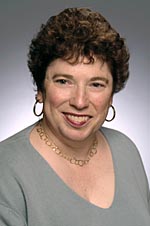May 15, 2006
CfAO director Claire Max to receive Chabot
Science Award
By Judyth Collin, Chabot Space & Science Center
The Chabot Space & Science Center in Oakland will award
the 2006 Chabot Science Award to Claire Max, professor of astronomy
and astrophysics and director of the Center for Adaptive Optics
at UCSC. The award will be presented at the Chabot Space &
Science Center's Gala on Saturday, May 20.

Claire Max and other CfAO scientists designed and built
an adaptive optics system for the W. M. Keck Observatory
in Hawaii.
|
The $5,000 award honors excellence in the field of scientific
and technological discovery and is in recognition of Max's work
in adaptive optics, a technology that can remove the blurring
effects of turbulence in the Earth's atmosphere, allowing telescopes
on the ground to see as clearly as if they were in space. Max
has been active in the development of advanced adaptive optics
systems for current and future large ground-based telescopes
and has observed nearby active galactic nuclei (galaxies with
black holes in their cores), the planet Neptune, and Saturn's
moon, Titan.
"We are extremely proud to have this opportunity to honor
Dr. Max for her outstanding contribution to science," said
Edward Penhoet, chair of the selection committee and a member
of Chabot's Board of Directors. "Not only is the use of
adaptive optics useful in learning about space objects and understanding
the universe, her research also promises to provide new tools
for the diagnosis of eye disease, and for improving the correction
of vision via laser surgery and contact lenses."
A fellow of the American Academy of Arts and Sciences and the
American Physical Society, Max received the E. O. Lawrence Award
in Physics in 2004. She earned her A.B. degree in astronomy
from Harvard University (Radcliffe College) and her Ph.D. in
astrophysical sciences and plasma physics from Princeton University.
The Center for Adaptive Optics, headquartered at UCSC, is one
of a number of Science and Technology Centers funded by the
National Science Foundation. The center is involved in the design
of a ground-based 30-meter telescope to be equipped with adaptive
optics. Once completed, the telescope will be able to make distant-galaxy
images that are more than ten times sharper than those of the
Hubble Space telescope, detect planets around young stars in
the closest "stellar nurseries," and see more clearly
what is happening close to the million-solar-mass black hole
in the core of our own Milky Way galaxy.
Stars twinkle at night because their light is distorted by
air currents in the atmosphere. Unless a telescope has an adaptive
optics system, the images received will be blurred and fuzzy.
This same blurring can occur in the living retina. The use of
adaptive optics technology can compensate for these aberrations,
enabling a new era in astronomy and human eye research and vision
correction.
Max and other CfAO scientists designed and built an adaptive
optics system for the W. M. Keck Observatory in Hawaii. The
cost was about 20 times less than the cost of building the
Hubble Telescope, yet Keck has a larger light-gathering area
and better resolution. Adaptive optics uses a high-speed computer
to actively compensate for the changing distortions that cause
blurring of images. The system also requires precision optics,
special sensors, and deformable mirrors.
Chabot's Gala is a fundraiser to support the center's public
and schools educational programs, as well as its teacher-training
programs. Through the generosity of an anonymous donor, a special
fund has been established to benefit the next two recipients
of the Chabot Science Award. The Gala will also include presentation
of the Accenture Teacher of the Year Award.
Chabot Space and Science Center, a Smithsonian affiliate, is
a nonprofit teaching and learning center focusing on astronomy
and the interrelationships of all the sciences. Its observatory,
planetarium, exhibits, and natural-park setting are a place
where a diverse population of students, teachers, and the public
can imagine, understand, and learn to shape their future through
science.